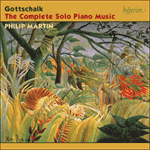
Welcome to Hyperion Records, a British classical label devoted to presenting high-quality recordings of music of all styles and from all periods from the twelfth century to the twenty-first.
Hyperion offers both CDs, and downloads in a number of formats. The site is also available in several languages.
Please use the dropdown buttons to set your preferred options, or use the checkbox to accept the defaults.

In addition, Gottschalk provides a note of encouragement to would-be performers to ‘endeavour to emphasize the iterated design of the accompaniment, so as to invariably convey to the listener the idea of […] 34 time’, though in some places ‘it would seem to indicate 68 time’. The effect he is seeking is the antagonism of the two conflicting rhythms, one of which is subordinate to the other. ‘If it be performed in an intelligent manner’, writes Gottschalk, ‘the auditor should be enabled to follow all the phases, and the entire action of the little sentimental drama […].’
The music was written in August 1859 while the composer was living in Matouba, Guadeloupe. It is dedicated to his friend the French pianist and composer Émile Prudent (1817–1863). The work also appears in expanded form with a spoken text by another friend, the critic Henry C Watson (RO191, New York, 1865).
from notes by Jeremy Nicholas © 2005
Dans une note d’encouragement, Gottschalk invite les futurs interprètes à «s’efforcer d’accuser le plan itératif de l’accompagnement, de manière à véhiculer invariablement chez l’auditeur l’idée d’une […] mesure à 34», même si, par endroits, «tout semblerait indiquer une mesure à 68». L’effet recherché est l’antagonisme entre ces deux rythmes conflictuels, subordonnés l’un à l’autre. «Si l’exécution est intelligente», écrit Gottschalk, «l’auditeur devrait pouvoir suivre et chaque phase et toute l’action de ce petit drame sentimental […]».
Gottschalk composa cette musique en août 1859, alors qu’il vivait à Matouba (Guadeloupe), et la dédia à son ami le pianiste/compositeur français Émile Prudent (1817–1863). Cette mélodie apparaît aussi, sous une forme développée, avec un texte déclamé d’un autre de ses amis, le critique Henry C. Watson (RO191, New York, 1865).
extrait des notes rédigées par Jeremy Nicholas © 2005
Français: Hypérion
Dazu liefert Gottschalk zur Ermunterung von angehenden Interpreten einen Hinweis. Sie sollen „versuchen, die Wiederholungsgesten in der Begleitung hervorzuheben, damit dem Hörer unmissverständlich der Eindruck eines […] 34-tel Takts vermittelt wird“, auch wenn man gelegentlich glauben würde, hier „handelt es sich um einen 68-tel Takt“. Damit erhoffte sich Gottschalk einen wirkungsvollen Antagonismus zwischen zwei kontrastierenden Rhythmen, von denen einer dem anderen untergeordnet ist. „Wenn man es [das Stück] in einer intelligenten Art aufführt“, schreibt Gottschalk, „müsste der Hörer allen Abschnitten und der gesamten Handlung dieses kleinen schwärmerischen Dramas […] folgen können.“
Die Musik wurde im August 1859 geschrieben, als der Komponist in Matouba, Guadeloupe wohnte. Das Stück ist seinem Freund, dem französischen Pianisten und Komponisten Émile Prudent (1817–1863) gewidmet. Das Werk gibt es auch in erweiterter Form mit einem gesprochenen Text von einem anderen Freund, dem Journalisten Henry C. Watson (RO191, New York, 1865).
aus dem Begleittext von Jeremy Nicholas © 2005
Deutsch: Elke Hockings
 Gottschalk: The Complete Solo Piano Music Gottschalk: The Complete Solo Piano MusicWith his idiomatic and graceful style, pianist Philip Martin has established himself as the foremost exponent of Gottschalk. The composer had a unique spontaneity and individuality which Martin’s performances bring vividly to the fore. The complet ...» More |

